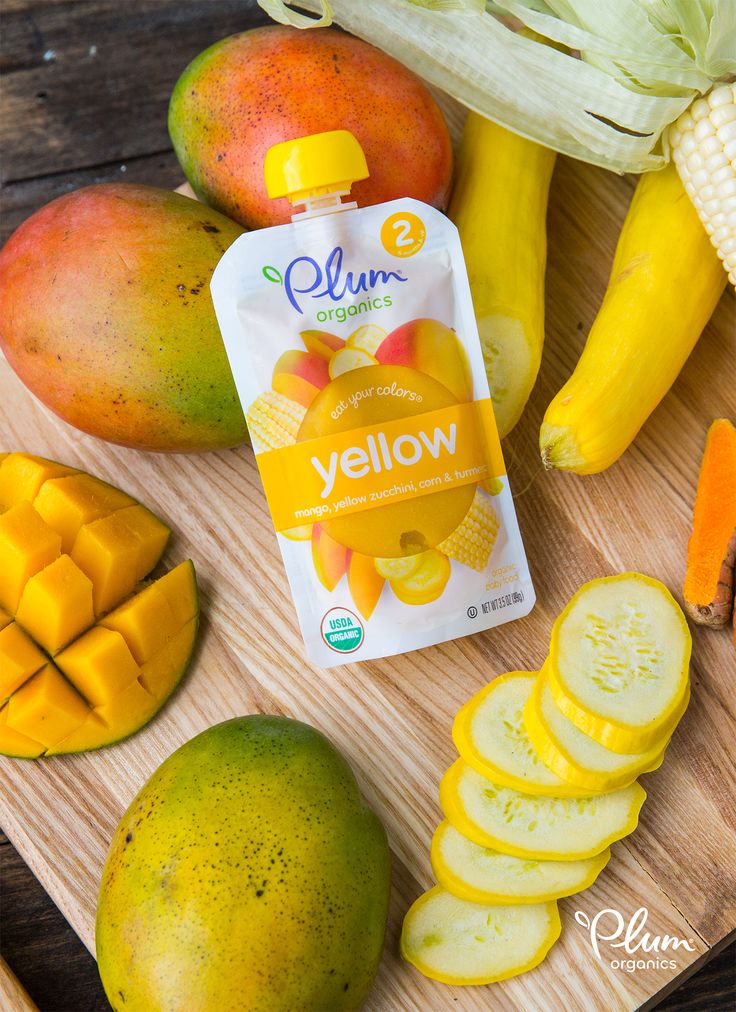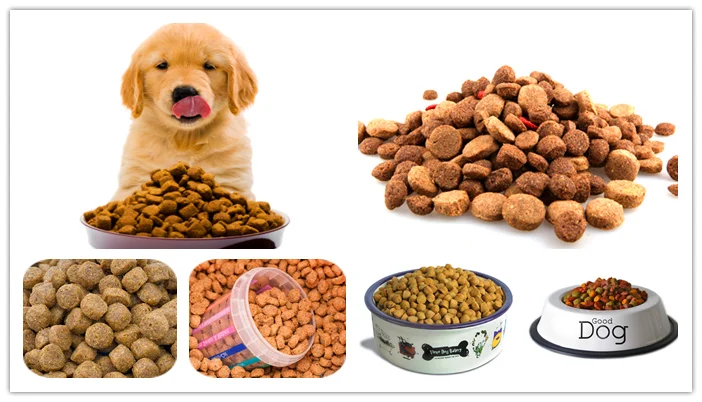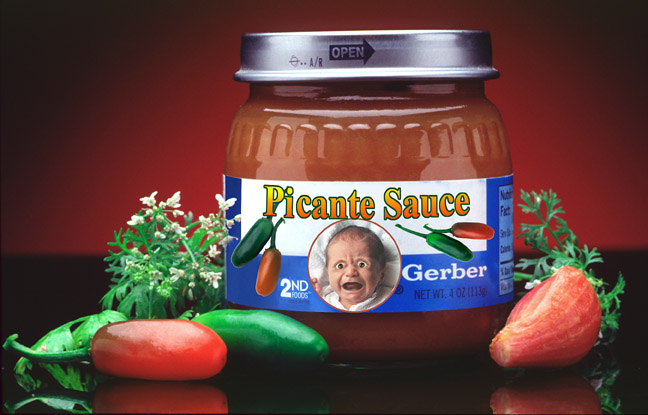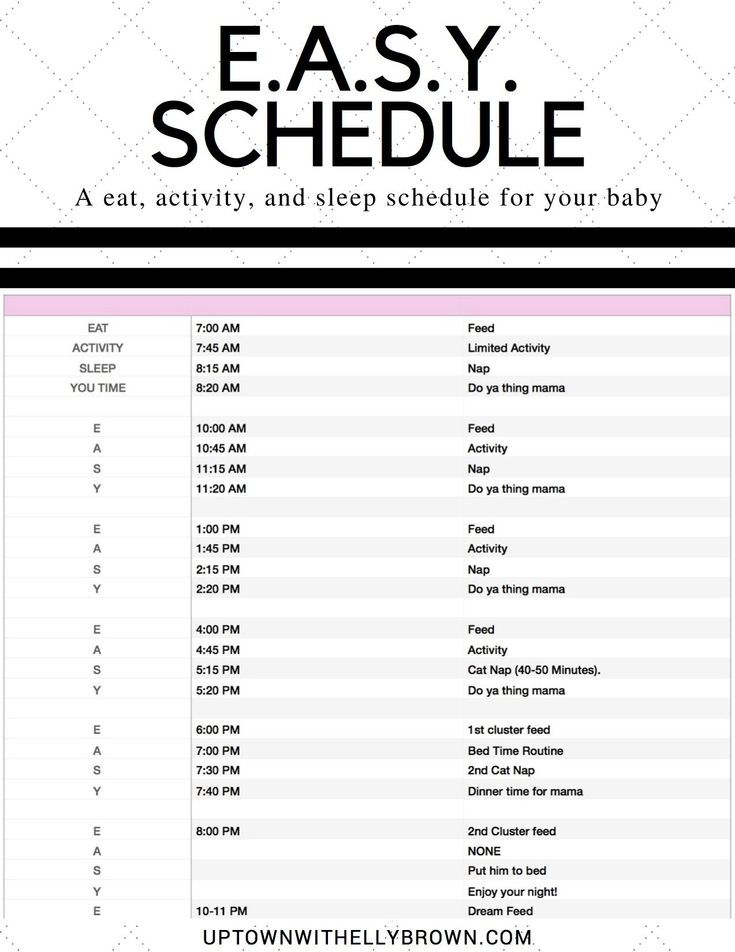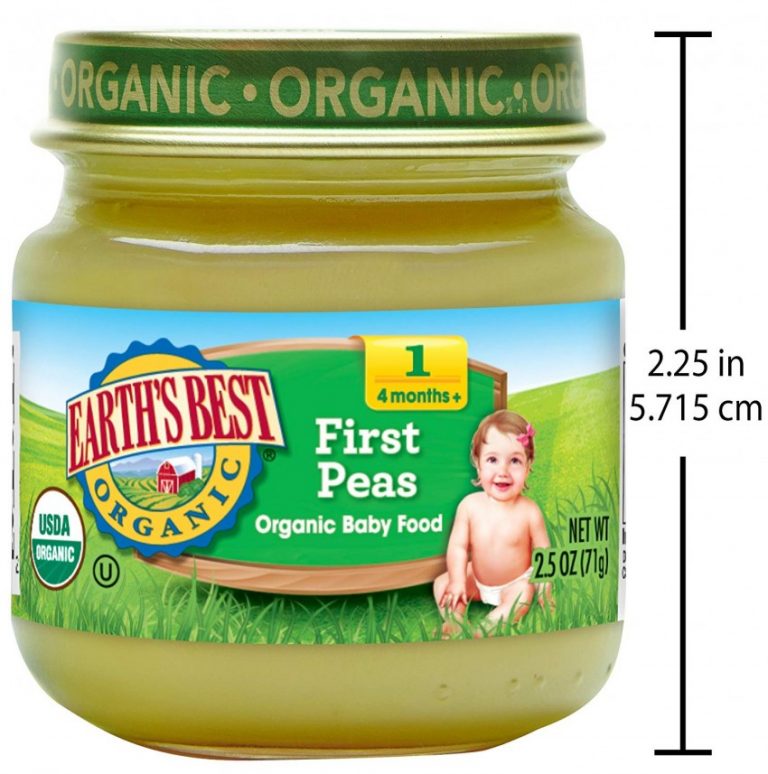Puree mango for baby food
Baby Mango Puree - Creative Nourish
Easy, no cook, this baby mango puree is loaded with vitamin C and is one of the best baby foods to start with. Sweet in taste and creamy in texture, it is absolutely delicious.
As you might already know, I am a huuuge fan of fresh, local and seasonal produce. But there are a few foods that most of us don't have locally available and have to compromise because they are just so good. Mango being one of them.
Mango is one of those foods that tastes perfect all on its own. So a stage 1 mango baby puree is a must-have when you start your baby on solid foods.
And not just because it's so easy to make but also because it tastes perfect, has a wonderful creamy texture and is full of great nutrients to keep your baby growing healthy.
Jump to:- Ingredients
- How to store mango?
- Mango Puree for Baby Benefits
- How To Make Mango Puree for Baby - 2 ways
- How to make frozen mango puree?
- How to make mango puree from fresh mangoes?
- Tips
- How to serve?
- How to store mango puree?
- Possible Variations
- Mango Baby Food Combinations
- FAQ
- More homemade baby food recipes:
- Recipe
- How to store mango puree?
Ingredients
Mango (obviously): when purchasing make sure that the mango is a little soft to the touch and free of any signs of deterioration. You don't want it to be squishy or have any dark spots or cracks.
How to store mango?
If it's not fully ripe, leave it at room temperature for up to 7 days until ripe.
When ripe, move to the refrigerator for about 5 days.
Mango Puree for Baby Benefits
Mango is a fruit that's really rich in vitamin C. But what most people maybe don't know is that it's also a great source of beta-carotene which is a precursor of vitamin A.
Another important thing for babies when they start solids is dietary fiber. This is because their little digestive systems might not be developed fully yet and the introduction of solids can lead to constipation.
So this is where food high in dietary fiber comes handy. And mangoes are just that.
They also contain a fair amount of B vitamins as well as minerals such as copper.
How To Make Mango Puree for Baby - 2 ways
Mango is one of those fruits that doesn't require any cooking before serving. Not even for a 6 month old's mango baby puree. Yessss!!!!!
Yessss!!!!!
There are two ways of making it though - from fresh mangoes and from frozen.
How to make frozen mango puree?
- Thaw the frozen mango three ways - either overnight in the fridge; place the sealed bag of mango in a bowl of cold water for about half an hour; or just pop it in a blender about 2 hours before you want to blend and let it thaw.
- Blend. Place the mango in the blender or food processor and blend until smooth. It may require a bit of water so you can add little by little making sure that it is not too runny.
- Serve or store for later use.
How to make mango puree from fresh mangoes?
- Cut the mango. Peel the mango and then cut around the seed. For the mango baby puree you don't really need to cut it further if you will be using a blender.
- Blend. Now that you’ve prepared your mango, just throw it in the blender.
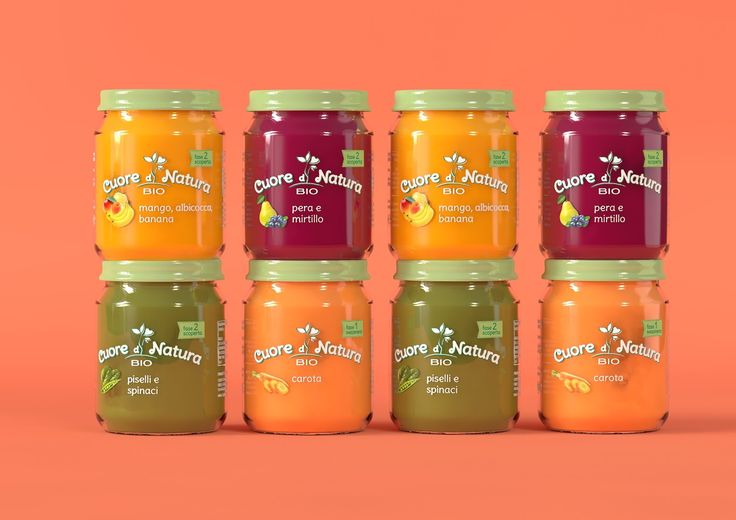 And blend until smooth. You can add a tablespoon of water to make it smoother but you will most likely not need it.
And blend until smooth. You can add a tablespoon of water to make it smoother but you will most likely not need it. - Serve or store for later use.
- There are certain blenders that were created just for baby food but we have always used either the inexpensive magic bullet, the Vitamix or a food processor for both our baby foods and every day for our (adult) smoothies.
- Serving size is just for guidance, but if your baby needs more or less food please follow their cues.
How to serve?
Have two spoons, one where you preload the puree and put it on baby's tray so they can play and explore and the other that you can use to feed the baby.
If you are feeding the baby then make sure to follow their cues, place the spoon in front of their mouth and patiently wait for them to open. That way they baby feels in control of what and how much they are eating and can become confident in parent/child communication.
A great option is to offer them both a puree option and baby-led weaning. That way you know they are getting some food, while they are still able to fully explore the fruit they are eating. For more info on how to offer mango baby-led weaning see under "Possible variations" below.
How to store mango puree?
- Store in an airtight container in the fridge for 3 days
- Freeze in an ice cube tray or small airtight containers up to 3 months
- To thaw, remove from the ice cube tray and place in a airtight container in the fridge overnight
Possible Variations
Mango doesn't necessarily need to be served as a baby puree. See some variations below.
Mashed. If you’re over the puree stage, transitioning from purees to finger food or simply want to start with mashed rather than smooth baby purees then this recipe is perfect if you modify the “how-to” part. Instead of putting in the blender, you can simply mash the food up together by pressing down on the mango with a fork.
You’d probably want your mango to be a fully ripe here so that it’s easier to mash.
MASHEDLumps. If you’re just a step away from finger food, you can also blend or mash one half of the mango and the leave the rest in pieces and then mix. That way your child will get used to new textures.
Mango Baby-led weaning. You'd also want your mango to be fully ripe here so that it's easy for your baby to chew on and avoid choking. Peel the mango and then cut into very thin slices.
You can read more about how to transition to finger foods here.
Mango Baby Food Combinations
Mango goes well with lots of different fruits. You can try pineapple, banana, sweet potato, peaches, nectaries, apricots, olive oil, cinnamon, nutmeg.
FAQ
Do you cook mango for baby puree?
No, mango for baby does not need to be cooked. Just peeled and blended.
What age can baby have mango puree?
Baby can have mango puree from when they start eating solid foods, so usually from around 5 months old or 6 months old.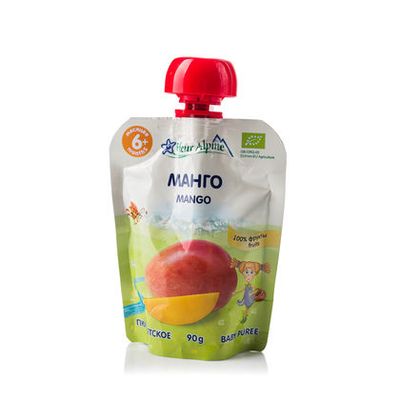
Is mango good for babies?
Mango is a fruit that has a high amount of vitamin C so it is a great option to give to your baby if you want to boost their immune system. It also has a lot of little compounds that can act as antioxidants and help your baby's body fight against all kinds of diseases.
More homemade baby food recipes:
Looking for other single-food baby puree recipes? Check these out:
- First Baby Puree - Avocado Baby Puree
- How To Make The Perfect Pear Baby Puree
- How To Make Baby's First Apple Puree
- Baked Sweet Potato for 6 month old baby
- Puree Carrots for Baby Recipe
Recipe
How to Make Mango Puree for Baby
Easy, no cook Mango Puree for your baby. Sweet in taste and with a creamy texture, mango is one of the best first foods to start your baby with.
5 from 5 votes
Author: Dora
Print Recipe Pin RecipePrep Time 5 mins
Cook Time 0 mins
Total Time 5 mins
Fridge Life? 3 days
Freezable? 3 months
- ▢
Small Blender
- ▢
Vitamix
- ▢
Baby storage tray
- ▢ 1 mango
Mango puree from frozen
Thaw the frozen mango three ways - either overnight in the fridge; place the sealed bag of mango in a bowl of cold water for about half an hour; or just pop it in a blender about 2 hours before you want to blend and let it thaw.
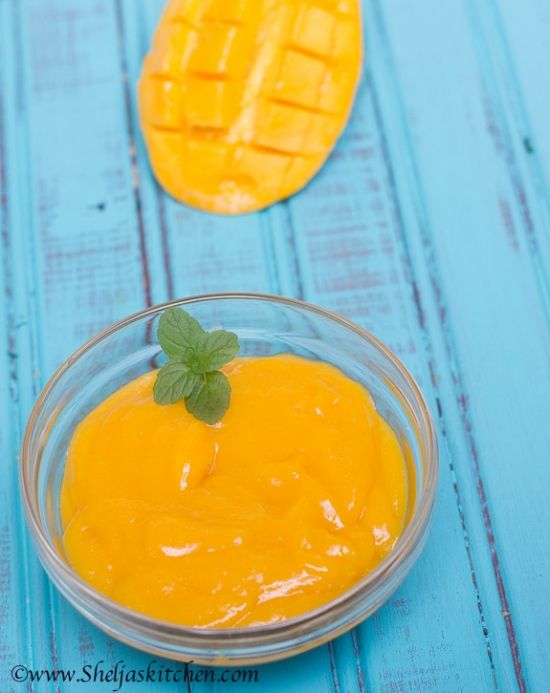
Blend. Place the mango in the blender or food processor and blend until smooth. It may require a bit of water so you can add little by little making sure that it is not too runny.
Serve or store for later use.
From fresh mangoes
Peel the mango and cut around the pit.
Cut the bigger pieces into cubes and place in a blender.
Blend. Add a tbsp of water and keep adding water until you reach the desired consistency.
- There are certain blenders that were created just for baby food but we have always used either the inexpensive magic bullet, the Vitamix or a food processor for both our baby foods and every day for our (adult) smoothies.
- Serving size is just for guidance, but if your baby needs more or less food please follow their cues.
- Serve on a preloaded spoon given to baby and have 1 spoon for yourself to feed her. See more details in post.
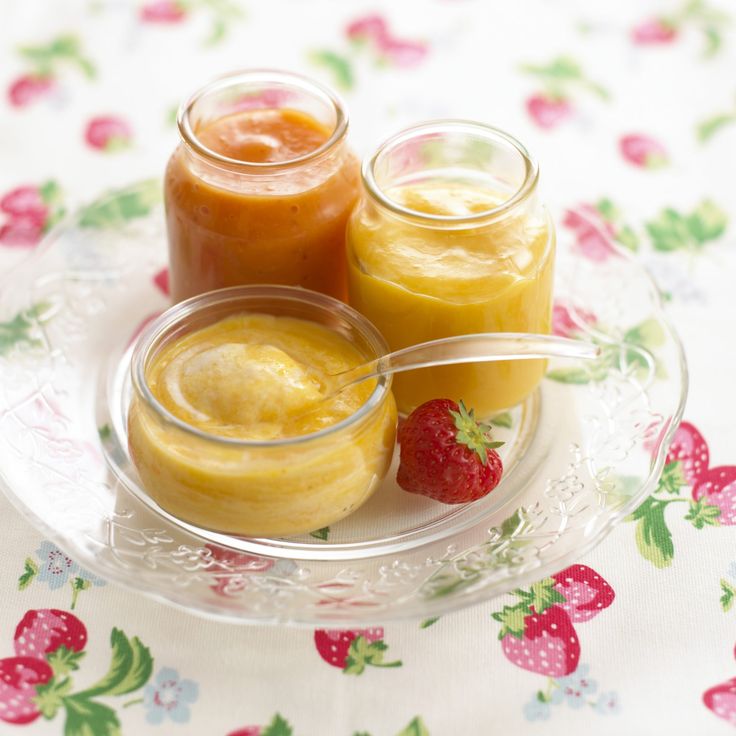
- Offer mango baby-led weaning and as a puree - that way you know they are getting some food, while they are still able to fully explore the fruit they are eating. For baby-led weaning peel and cut the mango into thin slices.
How to store mango puree?
- Store in an airtight container in the fridge for 3 days
- Freeze in an ice cube tray or small airtight containers up to 3 months
- To thaw, remove from the ice cube tray and place in a airtight container in the fridge overnight
Calories: 124kcalCarbohydrates: 31gProtein: 2gFat: 1gSaturated Fat: 1gPolyunsaturated Fat: 1gMonounsaturated Fat: 1gSodium: 2mgPotassium: 348mgFiber: 3gSugar: 28gVitamin A: 2240IUVitamin C: 75mgCalcium: 23mgIron: 1mg
Tried this recipe?Let us know how it was!
5-Minute Mango Puree and Toddlers
byAmy Palanjian
Updated
Jump to RecipeThis post may contain affiliate links.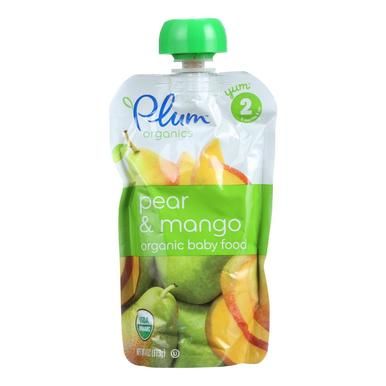 If you shop from one of our links, we may earn a commission.
If you shop from one of our links, we may earn a commission.
Learn the easiest way to transform fresh or frozen mango into a smooth homemade baby food with this easy Mango Puree. You can even make it ahead and freeze some for future week’s too. (I love it so much, I often eat it myself as an adult!)
Mango Puree
Mango is one of my older kid’s favorite fruits, so we almost always have some in the fridge or freezer. And once I realized that it was so easy to transform into puree when we had a baby in the house, everyone has been getting in on the vitamin C action!
This homemade baby food is naturally sweet and creamy. It’s really intensely flavorful and can be served on its own or paired with other foods including oatmeal, yogurt, pancakes, and, really, anything you think sounds good.
Ingredients You Need
To make this baby food puree, you need either fresh mango or frozen diced mango. If using fresh, you’ll want to cut it, which you can do by slicing off two large sections around the hard center.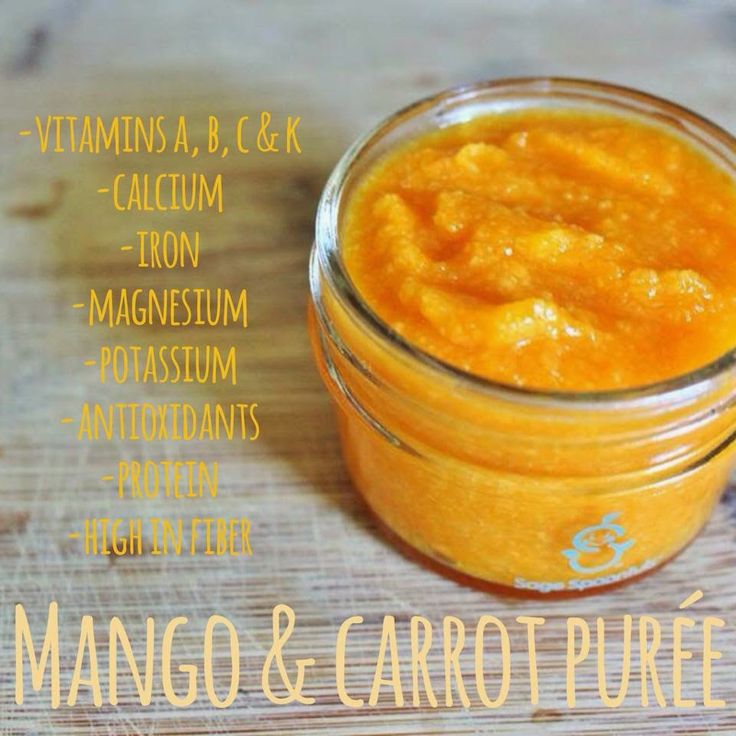 Then score lightly with a paring knife, push outward to expose the pieces, and cut off the flesh.
Then score lightly with a paring knife, push outward to expose the pieces, and cut off the flesh.
If using frozen, you’ll want to defrost it at room temperature, overnight in the fridge, or in 15-second increments in the microwave.
How to Make Mango Puree with Frozen Mango
This is so easy! Simply let frozen diced mango thaw overnight in the fridge, at room temperature, or briefly in the microwave. Then it’s ready to use in the recipe.
TIP: You don’t have to drain off the liquid from the thawed frozen mango, as it will blend right into the puree.
Step-by-Step Instructions
Here’s a look at how to make this easy mango puree. Scroll down for the full recipe.
- Add your diced mango to a blender.
- Blend until smooth, adding water, formula, or breastmilk if needed. (I usually don’t find that any additional liquid is needed if using thawed frozen mango, but depending on the ripeness of your fresh mango, you may need a little.
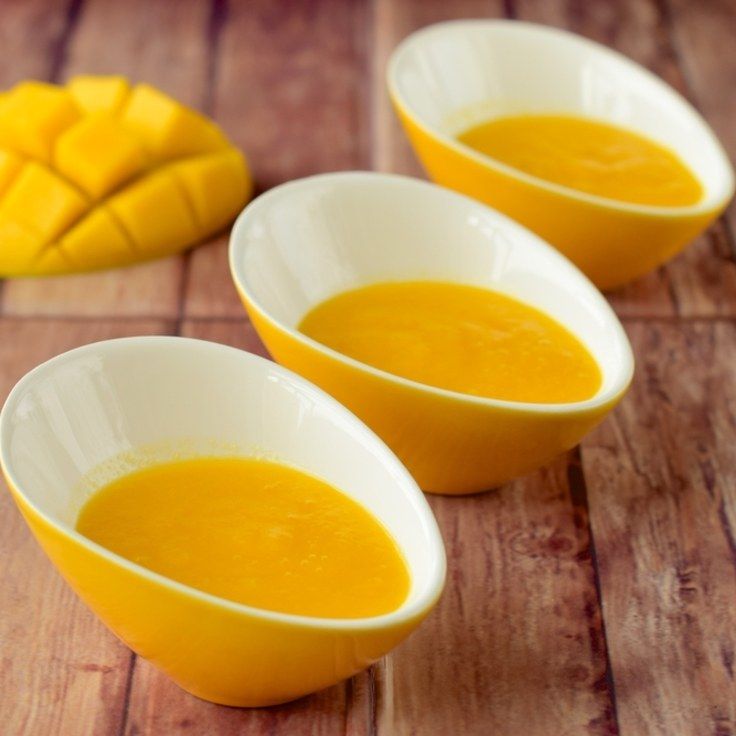 )
) - Serve or store for later.
TIP: I prefer to store this in small portions so it’s easy to pull out and serve or mix with other foods.
Frequently Asked Questions
What is mango puree made of?
Mango puree is made with just mango, which can be fresh mango or frozen mango of any variety.
What are mango puree uses?
You can serve it as is to a baby, stir it into other baby food, add it to yogurt, use it as a dip for pancakes, or even add it to your own mixed drinks.
What other foods can I mix this with?
It’s delicious with whole milk yogurt, cottage cheese, and oatmeal; drizzled over fish tacos, or used as a dip for Vanilla Waffles or 2-Ingredient Pancakes.
How to Store
- You can store any leftovers in the fridge in an airtight container for up to 3 days.
- To freeze, place spoonfuls into an ice cube tray.
 Freeze for 4-6 hours or overnight. Transfer to a freezer storage bag, date and label, and freeze for up to 3 months. Thaw overnight in an airtight container in the fridge.
Freeze for 4-6 hours or overnight. Transfer to a freezer storage bag, date and label, and freeze for up to 3 months. Thaw overnight in an airtight container in the fridge.
Best Tips for Success
- Use ripe mango, which should feel soft to the touch if fresh and not rock hard as an underripe mango would.
- You can use fresh or frozen mango.
- To use frozen mango, let it thaw in the fridge or at room temperature (or warm it in the microwave in 15 second increments) before starting the recipe.
- You don’t have to drain off the water from the thawed frozen mango, as it will blend right into the puree.
- Serve plain or stir into yogurt, cottage cheese, oatmeal, or overnight oats.
- This is really delicious in Mango Yogurt.
- See more of my favorite Baby Food Pouch recipes, Easy Mango Smoothie, Strawberry Yogurt, Strawberry Puree, and our favorite reusable pouches.
I’d love to hear your feedback on this recipe if you try it, so please comment below to share.
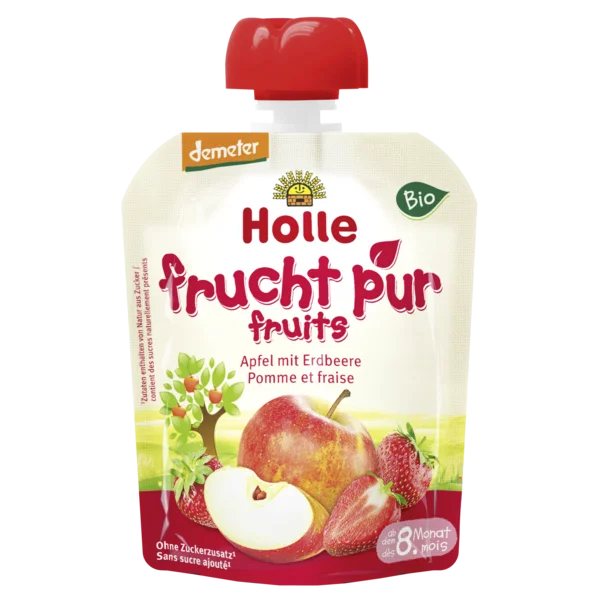
This post was first published January 2019.
Prep Time 5 minutes
Cook Time 0 minutes
Total Time 5 minutes
Author Amy Palanjian
Cuisine American
Course Baby Food
Calories 17kcal
Servings 6 servings
- ▢ 1 cup diced mango
- ▢ 2 tablespoons to ¼ cup water, formula, or breastmilk as needed
Place mango into blender.
Blend, adding liquid as needed, starting with the smaller amount.
Serve or store for future use.
Vitamix Blender
Silicone Ice Cube Tray
Reusable Pouch
- Use ripe mango, which should feel soft to the touch if fresh and not rock hard as an underripe mango would.
- You can use fresh or frozen mango. To use frozen mango, let it thaw in the fridge or at room temperature (or warm it briefly in the microwave) before starting the recipe.
- You don’t have to drain off the water from the thawed frozen mango as it will blend right into the puree.
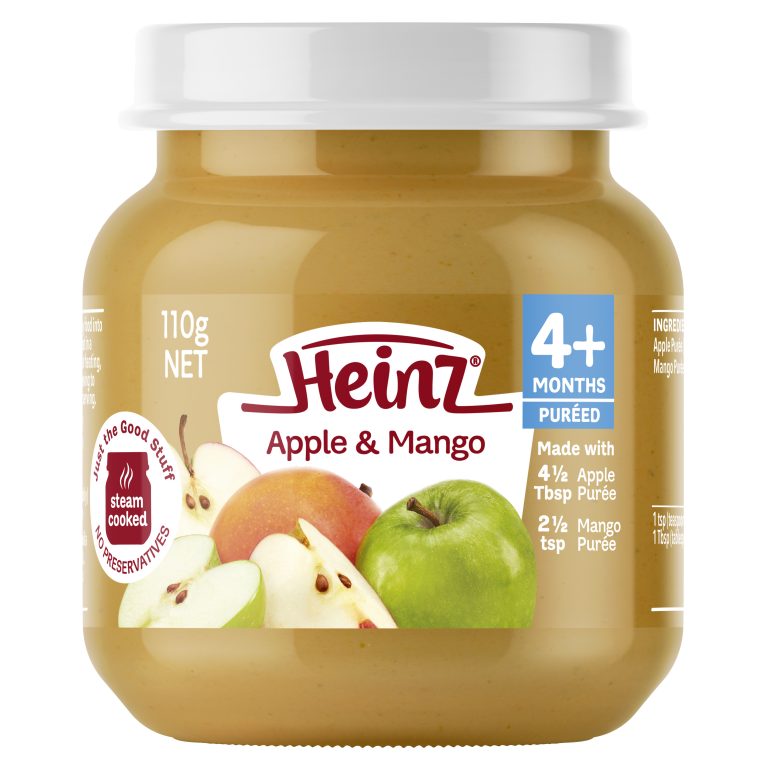
- You can store any leftovers in the fridge in an airtight container for up to 3 days.
- To freeze, place spoonfuls into an ice cube tray. Freeze for 4-6 hour or overnight. Transfer to a freezer storage bag, date and label, and freeze for up to 3 months. Thaw overnight in an airtight container in the fridge.
- A typical serving for a 6 to 7-month-old may be 1/2-1 tablespoons. An older baby may eat more than that.
- Serve plain or stir into yogurt, cottage cheese, oatmeal, or overnight oats.
Calories: 17kcal, Carbohydrates: 4g, Protein: 1g, Fat: 1g, Saturated Fat: 1g, Polyunsaturated Fat: 1g, Monounsaturated Fat: 1g, Sodium: 1mg, Potassium: 46mg, Fiber: 1g, Sugar: 4g, Vitamin A: 298IU, Vitamin C: 10mg, Calcium: 3mg, Iron: 1mg
Tried this recipe?Rate in the comments and tag @yummytoddlerfood on IG!
Related Posts
Related Products
Happy Family Meals (Meal Plans)
Buy Now
Happy Family Meals (Vol 2)
Buy Now
Yummy Toddler Snacks
Buy Now
Yummy Baby Food
Buy Now
Share it with the world
FacebookTweetPinFiled Under
Mango puree, 90 g with free home delivery from VkusVill
VkusVill
Juicy mango puree made without added sugar. Moderately sweet, with a delicate texture, it will appeal to both toddlers and older children. Sealed packaging allows you to take mashed potatoes with you on the road or for a walk. Thanks to the small neck, the baby learns to eat on his own and less often stains clothes. Recommended for children from 6 months. Suggested Use: Recommended for children 6 months and older, starting at 1/2 teaspoon per day, increasing to 100 g per day by 12 months. Shake before use. Open immediately before use. Do not reheat in the microwave. After removing the cap, remove it from the child. Do not leave children unattended while feeding. nine0003
Moderately sweet, with a delicate texture, it will appeal to both toddlers and older children. Sealed packaging allows you to take mashed potatoes with you on the road or for a walk. Thanks to the small neck, the baby learns to eat on his own and less often stains clothes. Recommended for children from 6 months. Suggested Use: Recommended for children 6 months and older, starting at 1/2 teaspoon per day, increasing to 100 g per day by 12 months. Shake before use. Open immediately before use. Do not reheat in the microwave. After removing the cap, remove it from the child. Do not leave children unattended while feeding. nine0003
From 6 months +
Vkusvill
73 rub/piece 73.00 73.00
Description
Juicy mango puree made without added sugar. Moderately sweet, with a delicate texture, it will appeal to both toddlers and older children. Sealed packaging allows you to take mashed potatoes with you on the road or for a walk. Thanks to the small neck, the baby learns to eat on his own and less often stains clothes.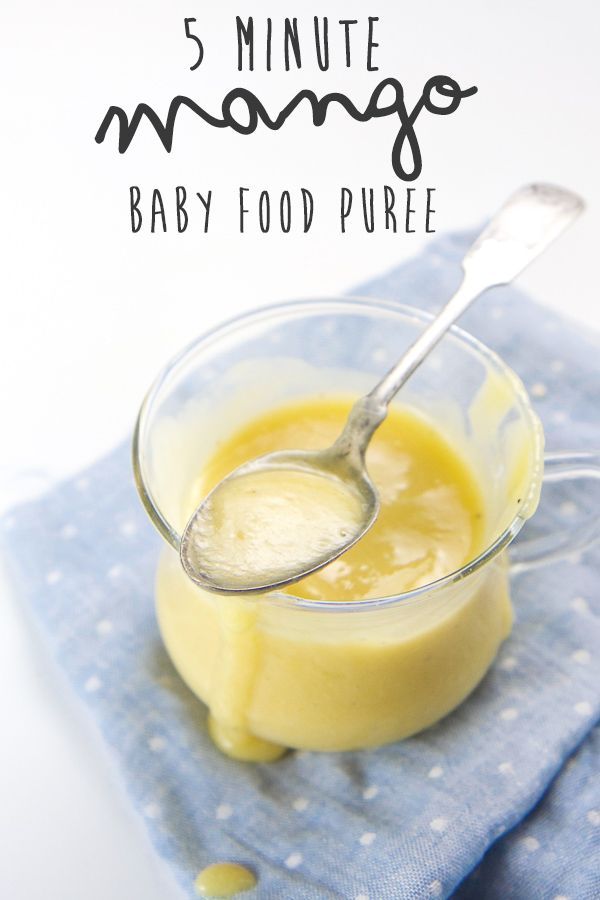 Recommended for children from 6 months.
Recommended for children from 6 months.
Suggested Use: Recommended for children 6 months and older, starting at 1/2 teaspoon per day, increasing to 100 g per day by 12 months. Shake before use. Open immediately before use. Do not reheat in the microwave. After removing the cap, remove it from the child. Do not leave children unattended while feeding. nine0003
Valid
12 months
Nutritional and energy value per 100 g
proteins 0.5 g, fats 0.3 g, carbohydrates 15 g; 64.7 kcal
Composition
mango puree. Contains sugars of natural (natural) origin.
Label information may vary slightly This item is supplied by multiple manufacturers, appearance and specifications may vary slightly. The actual data is indicated on the label. The price may differ depending on the region or the format of the point of sale (vending, micromarket). nine0003
- Weight/volume: 90 g
Show availability in stores
Mango puree
Properties of mango puree
Nutritional value and composition | Vitamins | Minerals
How much does mango puree cost (average price for 1 ban. )?
)?
Moscow and Moscow region
47 p.
Quite often, after a successful acquaintance of the baby with the first vaporous products based on fruits and berries characteristic of our region, many caring mothers want to pamper their child with more exotic types of complementary foods. Mango puree is a great option for this occasion. This product has excellent taste and a lot of useful properties for the child's body. nine0003
Currently, for the introduction of complementary foods in the form of mango puree, many experts in the field of pediatrics and baby food recommend using ready-made, so-called canned products. The composition includes high-quality natural raw materials in the form of crushed fresh mango pulp, as well as a small amount of ascorbic acid, which plays the role of an antioxidant.
However, some parents still remain true to themselves and prepare the first food for their babies on their own. In the case of mango puree, the preparation of the finished dish does not require specific skills and abilities in the field of cooking - it is prepared like many other types of fruit puree. nine0003
nine0003
The main requirement for the preparation of mango puree, which is intended specifically for the nutrition of young children, is the freshness and quality of the original product, that is, mango fruits. To choose the right fruit, you first need to look at the color of the mango - a ripe fruit is always colored in red and yellow tones.
In addition, an important condition is the choice based not only on visual perception, but also on tactile sensations - when buying, always check the mango by touch. A high-quality fruit, although quite hard, but when pressed, it springs well. You should not take fruits of small size, as they contain a smaller amount of pulp. nine0003
There are two ways to prepare mango puree for a baby - raw or using heat treatment. In any case, you first need to thoroughly rinse the fruits and free them from a dense peel, while removing a rather large bone. Juicy mango pulp is cut into cubes, after which it is crushed with improvised means - a blender, a food processor, a fork, or rubbed through a sieve.
By the way, even after warming up, mango puree does not lose its color saturation, exotic fruity aroma and extraordinary sweetness. In addition, you can not only use these cooking methods, but also bake juicy pulp in the oven, followed by grinding. nine0003
The benefits of mango puree for babies lies primarily in the high-vitamin composition of this product, which also has properties similar to apples and bananas - it helps to normalize bowel function, in particular, it is used for diarrhea. Crushed mango pulp, rich in minerals and vitamins, is recommended for use in case of inflammation of the mouth and gums, as well as for colds.
Calorie content of mango puree 60 kcal
Energy value of mango puree (Proportion of proteins, fats, carbohydrates - bju):
Protein: 0.2 g (~1 kcal)
Fat: 0.3 g (~3 kcal)
Carbohydrates: 14 g (~56 kcal)
Energy Ratio (b|g|s): 1%|5% |93%
Recipes with mango puree
Mango Chicken Salad
Mango Quick Dessert
Champagne Champagne Mango Cream Crockembush
Spinach Mango Smoothie
Proportions of product.
 How many grams?
How many grams? in 1 teaspoon 17 grams
In 1 tablespoon of 50 grams
in 1 glass 350 grams
in 1 bank 200 grams
Food value and puree composition of Mango
NZHK - saturated fatty acids
g
Mono- and dysaharida
14.8 g
Water
81.71 g
ash
0.5 g
Food fibers
1.8 g
Vitamins
7.6 mg
Vitamin PP (NE) (PP)
0.584 mg
Vitamin K (K)
4.2 μg
Vitamin E (E (TE))
1.2 mg
Vitamin C (C)
27.7 mg
Vitamin B9 (B9)
14 μg
Vitamin B6 (B6)
0.134 mg
Vitamin B5 (B5)
0.16 mg
Vitamin B2 (B2)
0.057 mg
Vitamin
0.058 mg
Vitamin A (RE) (A (RE))
38 mcg
Beta carotene
0.445 mg
Mineral substances
Selenium (SE)
0.6 μg
Marganese (MN)
0.